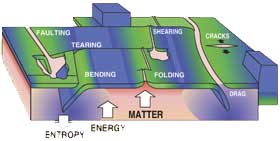 |
| The
General Theory of Plate Tectonics |
|
|
| |
Plate tectonics introduces
chemical, thermal, viscosity, melting and density
inhomogeneities into the mantle, and stress inhomogeneity
into the plates. Idealized models often assume uniform
mantle and rigid, homogeneous plates, and require
separate, ad hoc explanations for island chains, melting
anomalies and continental breakup. Plates, however,
drive and break themselves and organize the underlying
mantle, in common with other cooled-from-above systems.
Pressure, often ignored or
approximated in simulations, suppresses thermal expansion
and the Rayleigh number. This makes the deep mantle
a sluggish system with gigantic features, consistent
with tomography, and isolated from the upper mantle
and plate tectonics except by conduction and gravity.
Chemical stratification is thus likely.
Plate tectonics, with adjectives
such as rigid, homogeneous, isothermal, fixed, subsolidus,
reservoir, steady-state etc. dropped, is a much more
powerful concept than generally believed. Cracks,
rifts, dikes, incipient plate boundaries, melting
anomalies and variations in melt volume and chemistry
are natural parts of the General Theory of Plate Tectonics
just as plate boundaries and mountain belts are. The
long-sought-after alternative theory to plumes may
therefore just be a less restricted view of plate
tectonics. It appears to be the adjectives, assumptions
and other baggage that are the problem. |
Many
of the geochemical paradoxes associated with the plume
and primordial views of the mantle can be traced to
the reservoir concept where seismic boundaries are assumed
to delineate reservoirs. The mantle is heterogeneous,
and should be from plate tectonic considerations, which
involve recycling, inefficient melt and gas extraction,
and the history of subduction. This suggests that sampling
theory and the dispersed-component approach may be responsible
for the diversity of basalts. The Central Limit Theorem
predicts that large-scale averagers such as ridges should
have less variance and less extreme values than xenoliths,
inclusions, seamounts or ocean island basalts (OIB),
as observed. Homogeneity is achieved by sampling, not
by large scale convection. This idea has been tested
with Os and He isotopes, which are as different from
each other and from the standard isotopes as is possible. |

Much of the
buoyancy and resistance of plate tectonics is in the
plate-slab system, even though most of the energy and
mass is in the mantle. Without plates, mantle
convection could be described as a far-from-equilibrium
self-organized system (SOFFE). With plates, the mantle
feeds energy to the plates, which then become
the SOFFE system, and they organize mantle convection.
This is the reverse of what is usually assumed. |
Different
volcanoes average over different volumes of the
mantle and involve different degrees of melting, and
magma chamber processes differ. The Central Limit Theorem,
combined with mass balance calculations, obviates the
need for lower mantle or undegassed reservoirs or contributions
from these. Extreme values of isotopic ratios including
high 3He/4He ratios are predicted to occur in tectonic
environments that sample small volumes of the mantle
or involve small degrees of melting, such as oceanic
islandss and seamounts. The Central Limit Theorem means
that large volume averagers such as mid-ocean ridges
will not have such extreme values. |
The
conclusion is that both mid-ocean ridge basalts (MORB)
and OIB are products of a heterogeneous upper mantle,
sampled in different ways. |
|
|
